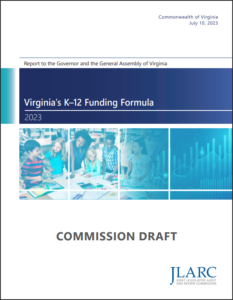Virginia public schools receive less funding from the state than the 50-state national average, less than the Mid-Atlantic regional average, and less than three of the five bordering states, says a new report from the Joint Legislative Audit and Review Commission (JLARC). The state needs to radically update its methodology for calculating Standards of Quality (SOQ), a measure of staff and other inputs that sets the bar for state funding. Adopting all of JLARC’s recommendations would cost taxpayers $1 billion in near-term funding and more than $2.5 billion longer-term.
Democrats and media allies immediately used the JLARC report to claim that Virginia schools are “underfunded.” As Axios Richmond puts it: “Virginia is cheaping out on public school funding compared to most other states.” Then there was this from House Minority Leader Don Scott Jr., D-Portsmouth: Virginia’s GOP “would rather fund corporate giveaways” than students’ education.
Republicans pushed back. Secretary of Education Aimee Guidera and Superintendent of Public Instruction Lisa Coons noted that the report omitted the last two fiscal years, in which Virginia has funneled an additional $3.2 billion in state aid to public schools. More to the point, they contend, without major reforms such as raising educational standards and improving reading competency in elementary schools, “investments in K-12 funding likely will not translate into improved student outcomes.”
The SOQ funding formula is “indecipherable,” said Guidera and Coons in a letter to JLARC Director Hal E. Greer. “The current formula lack of clarity contains arbitrary and restrictive provisions that limit the discretion of local school leaders to make effective resource allocations that will be meet student need. The Commonwealth’s formula is also antiquated and uses measures that were necessary proxies in earlier eras due to the dearth of student-level data available at the state level.”
After “historic spending increases,” the state needs to focus now on putting that investment to work, said Guidera and Coons.
Or, in the more colorful words of House Appropriations Chairman Barry Knight, R-Virginia Beach, “Sometimes throwing the money doesn’t always solve the problem.” The City of Richmond spends more per student than neighboring Henrico, he noted, but gets worse educational outcomes.
Defenders of the “mo’ money” school of educational policy point to the fact that some jurisdictions have higher populations of students who are economically disadvantaged, suffering from disabilities, or are English learners and, thus, have greater “needs.”
While suggesting numerous technical fixes for the Standards of Quality, the JLARC also floated the option of basing state aid on the number of students in a school jurisdiction. State aid could be adjusted for the number of special needs and English-learner students in a school district. A student-based method would be more transparent than the incomprehensible SOQ formula and would provide local school districts the flexibility to steer funds to local priorities.
